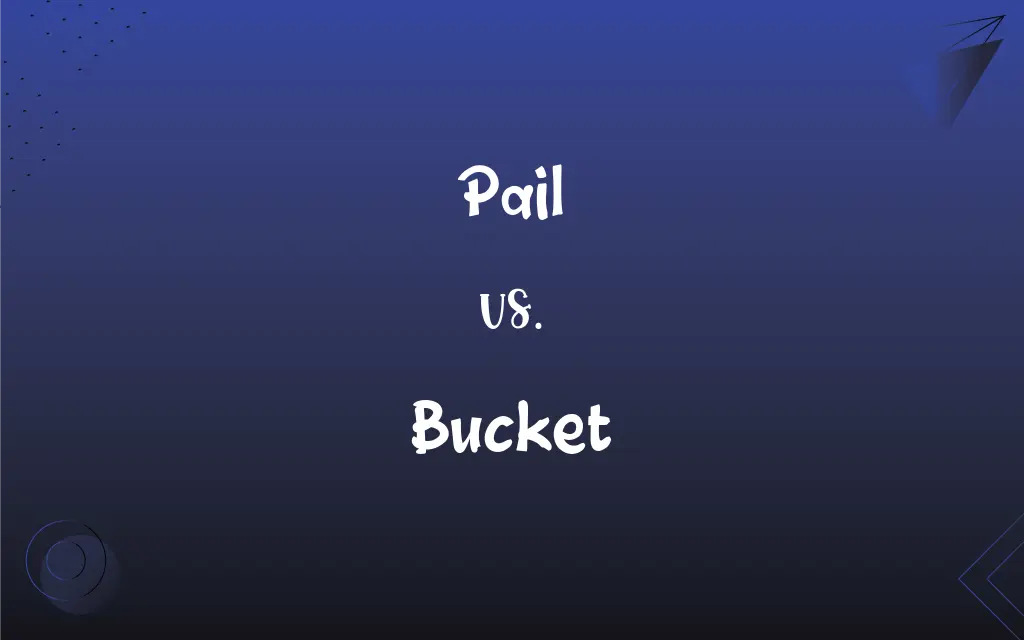Pail vs. Bucket: What's the Difference?
Edited by Janet White || By Harlon Moss || Updated on November 6, 2023
A "pail" often refers to a smaller, typically cylindrical container with a handle, while "bucket" is a more general term for a similar container of any size or shape.

Key Differences
The term "pail" typically conjures the image of a smaller, often cylindrical container used for tasks such as carrying liquids or other materials, often found in domestic settings. The word "pail" can sometimes suggest a more delicate or precise kind of container, potentially used for tasks requiring a certain level of care.
On the other hand, "bucket" is a broader term that encompasses a wide range of containers used for carrying solids or liquids. A bucket is recognized universally and is not confined to any particular size, shape, or material, which makes it a more versatile term in comparison to "pail."
The word "pail" is sometimes associated with specific uses, such as a milk pail, which is designed for collecting milk, implying a certain shape or design suitable for that purpose. In contrast, the word "bucket" lacks this specificity, implying that it can be designed for any number of uses, from mopping floors to carrying sand.
Pails may be used in more specialized contexts, such as in gardening or for food service, where a certain type of pail is preferred for its suitability for the task. Buckets, however, are common in both casual and industrial contexts, emphasizing their adaptability and robustness for a range of activities.
The choice between "pail" and "bucket" can also be influenced by regional dialects and traditions. In some regions, "pail" might be the more commonly used term in everyday language, while in other areas, "bucket" is the standard term for any container of this sort, regardless of its specific characteristics.
ADVERTISEMENT
Comparison Chart
Size
Generally smaller.
Can range from small to large.
Shape
Often cylindrical.
Can be of various shapes.
Usage Context
Domestic, delicate tasks.
Broad, including industrial use.
Specificity
Often used for specific purposes.
Used for a variety of purposes.
Dialectal Preference
Preferred term in certain regions.
More universally recognized term.
ADVERTISEMENT
Pail and Bucket Definitions
Pail
A small, usually cylindrical container with a handle.
She carried the fresh milk in a metal pail.
Bucket
A typically open-topped container with a handle for carrying.
He filled the bucket with water from the well.
Pail
A vessel for collecting or holding liquids.
The pail under the leak was nearly full.
Bucket
A pail used for catching leaks, bailing water, or disposing waste.
He placed a bucket under the dripping ceiling.
Pail
A portable container for carrying substances like paint.
He dipped his brush into the paint pail.
Bucket
A container used in various occupations, from construction to cleaning.
The worker carried a bucket of mortar to the site.
Pail
A bucket-like container used in households.
She filled the pail with warm soapy water for cleaning.
Bucket
A vessel for holding or carrying substances, including solids.
She tossed the popcorn into a large bucket.
Pail
A term often used interchangeably with bucket in casual speech.
The child built a sandcastle using a pail and shovel.
Bucket
An informal term for a large amount or collection.
Winning the lottery was a bucket of surprises.
Pail
A watertight cylindrical vessel, open at the top and fitted with a handle; a bucket.
Bucket
A cylindrical vessel used for holding or carrying liquids or solids; a pail.
Bucket
The amount that a bucket can hold
One bucket of paint will be enough for the ceiling.
FAQs
Are pails only used for liquids?
No, pails can be used for solids as well, like a sand pail.
Is a pail always made of metal?
No, pails can be made of various materials, including plastic.
Can "pail" and "bucket" be used interchangeably?
Often, but not always, depending on context and regional dialect.
Would you use a pail for industrial tasks?
It's less common as "bucket" is more associated with heavy-duty use.
Are there specific designs for buckets?
Buckets can come in many designs suited to different tasks.
Can both pails and buckets have lids?
Yes, both can be fitted with lids.
Are pails used for food service?
Yes, specially designed pails are used in food service.
Do buckets have a fixed volume?
No, they can vary greatly in size and capacity.
Do buckets always have handles?
Typically, yes, buckets usually have handles for carrying.
Can you sit on a pail or bucket?
It's possible if it's sturdy enough, but not recommended.
Can the term "bucket" refer to a small container?
Yes, "bucket" can refer to containers of various sizes.
Do the terms have different origins?
Yes, "pail" has Old English roots, and "bucket" has French origins.
Are buckets always round?
No, they can be of various shapes, including square.
Can pails and buckets be collapsible?
Yes, both come in collapsible varieties for easy storage.
Are there decorative pails and buckets?
Yes, both can be decorative and functional.
Is a "pail" considered more formal than "bucket"?
Not necessarily; it depends on the context.
Are pails considered children's toys?
They can be, particularly in the context of sand pails.
Do all pails and buckets have flat bottoms?
Most do for stability, but there can be exceptions.
Is a pail always smaller than a bucket?
Typically, but this is not a strict rule.
Do both pails and buckets come with spouts?
Pails more commonly have spouts; buckets less so.
About Author
Written by
Harlon MossHarlon is a seasoned quality moderator and accomplished content writer for Difference Wiki. An alumnus of the prestigious University of California, he earned his degree in Computer Science. Leveraging his academic background, Harlon brings a meticulous and informed perspective to his work, ensuring content accuracy and excellence.
Edited by
Janet WhiteJanet White has been an esteemed writer and blogger for Difference Wiki. Holding a Master's degree in Science and Medical Journalism from the prestigious Boston University, she has consistently demonstrated her expertise and passion for her field. When she's not immersed in her work, Janet relishes her time exercising, delving into a good book, and cherishing moments with friends and family.































































